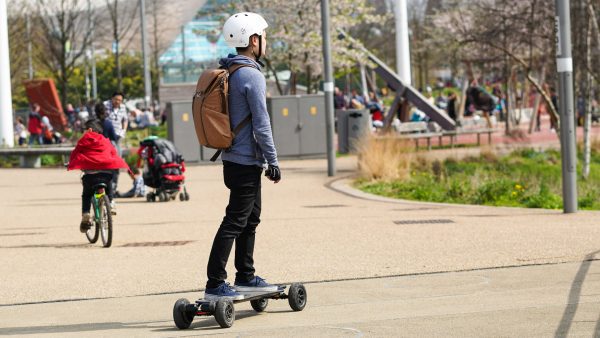The electric skateboard revolutionized urban transport and outdoor recreation, offering an alternative to traditional commuting.

With their sleek design and powerful electric motors, these innovative skateboards have quickly become a favorite among commuters, thrill-seekers, and adventure enthusiasts alike. Electric skateboards not only provide an exciting and convenient way to buy and navigate through city streets and parks but also present an opportunity for riders to embark on longer journeys and explore new horizons.
However, for those considering venturing beyond the confines of short commutes or casual rides, a critical factor comes into play: the power duration of the electric skateboard. The electric skateboard life is the lifeblood of these electrifying companions, dictating the maximum distance a rider can cover on a single charge. Understanding the nuances of the power duration of your e-skateboard battery life is crucial for planning extended trips, achieving long range, and ensuring a smooth, uninterrupted experience at top speed.
In this exploration of the power duration of your electric skateboard, we will delve into the key factors that influence the range of these sleek electric-powered boards. From capacity and riding styles to terrain variations and external influences, we will dissect the elements that directly impact an electric skateboard’s range. Additionally, we will offer valuable tips and best practices to help riders maximize their electric skateboard’s power duration during motorized long rides, enabling them to conquer new challenges and enjoy the freedom of boundless exploration.
Join us as we uncover the secrets to unlocking the full potential of your electric skateboard’s battery life and empowering you to embark on thrilling adventures with confidence and preparedness. Let’s dive into the world of the battery life duration of your electric skateboard and discover the pathways to extraordinary journeys on these captivating electric-powered e-skateboards.
Key Takeaways
- The life of your electric skateboard battery significantly impacts the range and overall performance of the skateboard, especially when considering a boosted board with a hub motor.
- Power duration factors include capacity, riding style, terrain, rider weight, speed, environmental conditions, and battery health.
- To maximize power duration, choose an electric skateboard with a higher capacity and adopt a smoother riding style to conserve energy.
- Plan routes with flatter and smoother surfaces to optimize range, and avoid aggressive riding and extreme temperatures.
- Charge the board correctly, avoid overcharging, and store the skateboard with the battery at around 50% charge if not in use for an extended period.
- When riding your best electric skateboard, utilize regenerative braking and consider using eco mode to conserve energy during long rides, while also ensuring your grip tape is in good condition.
- Regularly inspect the skateboard shop’s battery, connections, and charging port for cleanliness and damage.
- Seek professional help or contact the manufacturer’s support for battery-related troubleshooting or physical damage.
- Staying updated with the latest technologies and following manufacturer guidelines for maintenance and firmware updates is essential for optimal battery.
- By maximizing battery life, skaters can confidently explore new horizons, enjoy longer rides, and contribute to a greener and more sustainable future.
Understanding Your Electric Skateboard’s
Electric skateboards have gained popularity as a convenient and eco-friendly means of transportation for short commutes and recreational purposes. However, when considering longer rides, it’s essential to factor in the battery life duration of the electric skateboard. The power duration will determine the maximum distance you can travel on a single charge, and it’s crucial to plan accordingly to avoid getting stranded.

- Capacity: When considering the best electric skateboard, it’s essential to understand the nuances of the type of battery, including capacities measured in watt-hours (Wh) or ampere-hours (Ah) which can greatly affect the performance of the motor. A higher capacity generally means a longer range. For example, a skateboard with a 200Wh battery might have a range of 10-15 miles, while a 400Wh battery could offer a range of 20-30 miles. Check the specifications of your skateboard to determine its battery capacity.
- Riding Style: Your riding style also affects the power duration. If you ride aggressively, accelerate and brake often, or go uphill frequently, the battery will drain faster compared to a more relaxed and moderate riding style.
- Terrain: The terrain you ride on impacts power duration. Riding on flat, smooth surfaces consumes less power compared to uphill climbs or rough, hilly terrains, which put more strain on the motor.
- Rider Weight: The weight of the rider affects the performance and range of the electric skateboard. Heavier riders will experience slightly shorter ranges than lighter riders using the same skateboard.
- Speed: Higher speeds drain the battery faster. If you consistently ride at top speeds, expect a shorter range compared to riding at moderate speeds.
- Environmental Factors: power duration can be influenced by external conditions like temperature. Extremely cold or hot weather might affect the battery’s efficiency and reduce range.
- Battery Health: Over time, lithium-ion batteries can degrade, leading to reduced capacity and range. Regular maintenance and proper charging habits can help preserve the battery’s health and extend its lifespan.
- Regenerative Braking: Some electric skateboards come with regenerative braking, which recharges the battery when you brake or go downhill. While it won’t fully replenish the battery, it can slightly increase the overall range.
Tips To Get The Most Out Of Your Electric Skateboard During Long Rides
- Plan your route and be aware of charging stations along the way if possible.
- Ride at moderate speeds and avoid aggressive acceleration and braking.
- If you have the option, use eco or lower power modes when you don’t need maximum speed.
- Avoid riding in extreme temperatures if possible, as this can impact battery performance.
- Carry your charger if you expect to need a recharge during your journey.
- Be mindful of your battery level and range, especially if you’re exploring new routes or unfamiliar terrain.

Remember that manufacturers’ claimed ranges are often based on optimal conditions, so real-world ranges may vary. It’s always a good idea to leave some margin for unexpected detours or delays.
Factors That Affect Electric Skateboards’ Battery Life
The battery life duration of your electric skateboard is influenced by various factors that directly impact its range and overall performance. The battery life capacity, measured in watt-hours or ampere-hours, plays a significant role in determining how far the electric skateboard can travel on a single charge. Riding style, terrain, and elevation also affect battery consumption, with aggressive riding, uphill climbs, and rough terrains draining the battery faster. Rider weight and speed are additional factors, as heavier riders and higher speeds tend to reduce the range. External conditions, like temperature, can impact battery life efficiency, and battery health and age also play a role in long-term performance. Regenerative braking, present in some electric skateboards, slightly recharges the battery during braking or downhill riding. By understanding and managing these factors, riders can optimize their electric skateboard’s power duration and embark on longer journeys with confidence.
How To Maximize Your Electric Skateboard Battery Capacity
To maximize your electric skateboard‘s power duration and get the most out of each charge, follow these tips and best practices:
- Choose the Right Battery: When purchasing an electric skateboard, consider opting for a model with a higher battery capacity (measured in watt-hours or ampere-hours) to ensure a longer range.
- Optimize Riding Style: Avoid aggressive riding, rapid acceleration, and abrupt braking. Adopt a smoother and more controlled riding style to conserve battery power.
- Be Mindful of Terrain: Plan your route to include flatter and smoother surfaces whenever possible, as riding uphill or on rough terrains consumes more energy.
- Manage Speed: Maintaining moderate speeds will help extend your power duration. Resist the temptation to consistently ride at top speeds.
- Reduce Weight: If feasible, travel light to decrease the load on the skateboard and conserve battery power.
- Stay Mindful of Weather: Extreme temperatures can impact performance. If possible, ride in moderate weather conditions.
- Charge Wisely: Follow the manufacturer’s guidelines for charging your skateboard. Avoid letting the battery drain completely before recharging, and try to charge the battery before it reaches critically low levels.
- Avoid Overcharging: Once your skateboard is fully charged, unplug it from the charger to prevent overcharging, which can degrade the battery over time.
- Battery Storage: If you won’t be using the skateboard for an extended period, store it with the battery at around 50% charge in a cool, dry place.
- Utilize Regenerative Braking: If your electric skateboard has regenerative braking, take advantage of it. When braking or going downhill, regenerative braking can slightly recharge the battery.
- Use Eco Mode: Many electric skateboards offer different riding modes. If maximum speed isn’t necessary, switch to an eco or beginner mode to conserve energy.
- Maintain Power Health: Keep the battery and its connections clean and free of debris. Regularly inspect and clean the charging port and ensure it is dry before plugging in.
- Ride Smart: Plan your rides efficiently and be aware of charging stations or available power outlets along your route in case you need to recharge.
- Keep Firmware Updated: Manufacturers sometimes release firmware updates that can optimize efficiency and performance. Check for updates regularly and keep your skateboard’s firmware up to date.
By incorporating these practices into your electric skateboard usage, you can extend your power duration, enhance your riding experience, and confidently take on longer journeys without the worry of running out of power.
Troubleshooting Electric Skateboard Battery Problems
If you encounter battery-related issues with your electric skateboard, troubleshooting can help identify and resolve the problem. Here are some common battery problems and their possible solutions:
- Short Range/Reduced Power Life:
- Check your riding style: Aggressive riding, frequent acceleration, and high speeds can lead to shorter range. Adopt a smoother riding style to conserve battery power.
- Inspect tire pressure: Low tire pressure can increase rolling resistance and decrease range. Ensure your skateboard tires are properly inflated.
- Verify terrain: Riding on uphill or rough terrains consumes more energy. Plan routes with flatter and smoother surfaces for longer rides.
- Sudden Shutdown or Power Loss:
- Check battery connections: Ensure all connections are secure and free from dirt or debris.
- Inspect battery health: If the battery is old or damaged, it may not hold a charge properly. Consider replacing the battery if necessary.
- Unit Not Charging:
- Check charging port and cable: Ensure the charging port on the skateboard and the charging cable are clean and undamaged.
- Verify power source: Test the power outlet or charger on another device to ensure it’s functioning correctly.
- Inspect charger LED: Some chargers have indicator lights. If the LED doesn’t light up, the charger may be faulty.
- Overheating:
- Avoid extreme conditions: Riding in hot weather or direct sunlight can lead to overheating. Try to ride during cooler times of the day or in the shade.
- Reduce load: If carrying heavy items or an additional rider, it can strain the battery and cause overheating.
- Inaccurate Battery Indicator:
- Calibrate the battery: If the battery indicator seems inaccurate, try calibrating it. Fully charge the skateboard and then fully discharge it before charging it again.
- Update firmware: Check if there are any firmware updates available for your skateboard that may address battery indicator issues.
- Battery Swelling or Physical Damage:
- Stop using immediately: If you notice battery swelling, leakage, or physical damage, discontinue use and avoid charging the skateboard.
- Contact the manufacturer: Reach out to the skateboard manufacturer for guidance on how to handle a damaged battery safely and inquire about potential replacements.
Always refer to the manufacturer’s user manual and guidelines for specific troubleshooting steps, as different e-board models may have unique requirements and solutions. If you are unsure about handling battery-related issues or if the problems persist after troubleshooting, seek assistance from a professional or contact the manufacturer’s customer support for further help. It’s essential to prioritize safety when dealing with battery-related problems to avoid potential hazards or damage to the electric skateboard.
Skateboard Battery Life
Conclusion
Understanding and effectively managing the lower quality, high temperatures, and loose parts of your electric skateboard is crucial for maximizing your riding experience and exploring the full potential of this eco-friendly mode of transportation. By considering factors such as battery life capacity, riding style, terrain, speed, and environmental conditions, riders can make informed choices to optimize their electric skateboard’s range during long rides.
Adopting energy-efficient riding habits, maintaining the battery’s health, and utilizing features like regenerative braking can help extend battery life duration and ensure smoother, uninterrupted journeys. Being mindful of battery-related troubleshooting and taking advantage of appropriate actions when facing issues can further enhance safety and overall performance.
As electric skateboards continue to evolve and become more sophisticated, it is essential to stay updated with the latest technologies and follow manufacturer guidelines for charging maintenance, and firmware updates. Embracing these simple tips empowers riders to routinely check and confidently venture into new horizons, embracing the freedom of exploration, and contributing to a greener and sustainable future with every ride.
So, whether you’re commuting through bustling city streets, embarking on exhilarating adventures, or simply enjoying the thrill of riding, maximizing your skateboard’s battery life duration is an important factor that enables you to truly embrace the thrill of the journey and make the most of every moment on your electrifying ride.
Frequently Asked Questions (FAQs):
